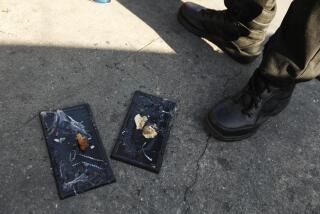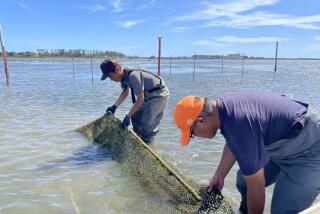Japan Fishing Industry to Halt Use of Drift Nets
- Share via
In a dramatic reversal, Japan has agreed to halt the use of drift nets on the high seas, a practice that has indiscriminately killed thousands of marine mammals and sea birds and provoked an international outcry.
By the end of 1992, the drift nets, which can stretch for miles and have been described by environmentalists as “curtains of death,” will be banned entirely. The phase-out will begin Jan. 1.
Japan’s decision was approved today by the cabinet of Prime Minister Kiichi Miyazawa and confirmed by a Foreign Ministry spokesman. It followed “intensive pressure” by Secretary of State James A. Baker III and Commerce Secretary Robert A. Mosbacher, one Washington source said. The United Nations was also poised to take action on a U.S. resolution to ban the nets.
Environmentalists in the United States hailed Japan’s decision as a “historic victory” for the cause of conservation.
“It’s one of the most significant environmental victories we have seen in this decade,” said Robert Sulnic, executive director of the Santa Monica-based American Oceans Campaign.
In Washington, a spokesman for the Department of Commerce called the decision “a very positive development in global environmental protection.” They, as well as U.S. officials who asked to remain anonymous, said Monday night that they hope it will step up pressure on Korea--the last holdout among nations with major Pacific fishing fleets--to quickly follow suit.
The Japanese drift net fleet is by far the most formidable in the Pacific, with 400 to 600 boats; Taiwan and Korea each have about 200 drift net boats. Taiwan announced last August that it would cease using the nets by next July.
Last year, a U.S. government study found that 10% of drift net ships killed 1,758 whales and dolphins, 30,464 sea birds, 253,288 tuna, 81,956 blue sharks and more than 3 million other fish that were not the intended catch.
Monday’s decision stunned the Japan Squid Driftnet Fishery Assn., which is scheduled to open a large conference on the subject this Friday.
“Now things are very confused and we don’t know how to react,” association director Tsutomu Ozaki told The Times. “Up to now the government was on our side and the United States and the United Nations were our enemy. Now that the (Japanese) government has gone to the other side we don’t know what to do,” Ozaki said.
The government was discussing ways to compensate Japanese fishermen. Earlier this month, Koji Imura, chairman of the squid drift net association, told the Associated Press that a ban would cost fishermen and squid processing companies an estimated $770 million a year.
He charged that the number of unintended deaths attributed to the nets had been “vastly misrepresented” by “emotional” environmentalists in the United States.
Drift nets, which were introduced in the early 1960s, have allowed fishermen to dramatically increase their catch. The nets, made of monofilament mesh, are shot across the anticipated path of schools of fish, which are trapped when their gills are snagged. Some nets are 30 miles long. Drift net technology was pioneered by a U.N. agency to help impoverished Asian nations increase the yields of what had been subsistence fishing.
Under terms of the agreement, half of the Japanese drift nets would be phased out by June 30. By the end of 1992, their use would be completely eliminated, U.S. sources said.
That is still six months behind the proposed June 30, 1992, deadline for a total ban proposed by the United States in a resolution introduced last year before the U.N. General Assembly.
In Tokyo, Japanese officials indicated that if some technical means were found that allowed its fishermen to continue using the nets without killing marine mammals and birds, it was possible their use could be resumed. There has been talk, for example, of using subsurface nets that do not harm birds.
But preventing dolphins, whales and fish that are not part of the targeted catch from becoming ensnared in the nets seems a much more daunting task.
One U.S. government source said he believed the charge in heart came in part because of Prime Minister Miyazawa, who took office this month, succeeding Toshiki Kaifu.
Another Bush Administration source observed, “I think the U.S. has been leaning on Japan for a long time to improve its international environmental (practices) with regard to whales and drift nets that are unbecoming of Japan as a leading nation.”
The U.S. estimates of drift net kills were based on observations in the last few years by U.S. and other foreign observers placed on board Japanese, Korean, and Taiwanese ships under bilateral agreements with the United States. The agreements also permitted the United States to install radio beacons on the ships, allowing them to be tracked by U.S. space satellites.
While Japan, Taiwan and Korea use the nets to fish for squid, the United States has caught some foreign drift netters going after salmon. Recently, charges were filed against Taiwanese ships for snagging salmon with the drift nets, a practice that has enraged U.S. fishermen and environmentalists alike.
Stammer reported from Los Angeles and Helm from Tokyo.
More to Read
Sign up for Essential California
The most important California stories and recommendations in your inbox every morning.
You may occasionally receive promotional content from the Los Angeles Times.













